|
|
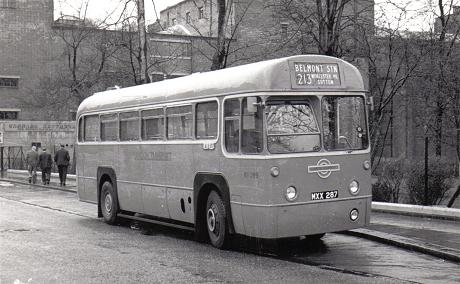 Red RF routes Red RF routes
Route 213
Page last updated 27 December
2018
Known on the timetable as
Belmont California, the blinds referred to Belmont
Station, just across the road. Here Sutton's RF399 stops at
Sutton Granada - and appears deserted, perhaps awaiting a new crew
up from Sutton Garage.
Photo Peter Gomm
collection
Another early single-deck route and one of the initial RF
routes, the 213 operated from Kingston to Belmont via Sutton for
many years. Its last reason for being single-deck, the bridge
at Worcester Park station, was removed
when the road was lowered in 1963, whereupon the route converted to
RT operation.
Dates of RF operation
12 Dec 52 to 7 May 63
(total 10 years, 5 months, all crew operation)
Destinations
KINGSTON Bus Station and BELMONT
California (daily 12 Dec 52 to 2 Jan 62, Suns 3 Jan
62 to 7 May 63)
KINGSTON Bus Station and SUTTON GARAGE (Mon-Sat
3 Jan 62 to 7 May 63)
RF Garages
NB Norbiton
A Sutton
K Kingston (Sun from 16 Aug 61)
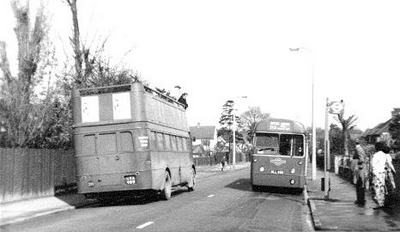
Reason for single-deck operation
Low rail bridges on the route at Norbiton, New Malden and
Worcester Park. In 1962, the route was diverted to serve
Kingston Hospital, thereby avoiding the Norbiton bridge. Also
at about this time, the road was lowered beneath the New Malden
bridge, leaving Worcester Park as the only obstacle to
double-deckers. This bridge was
rebuilt in 1962 and the route was double-decked the following
year.
Treelopper 973J (formerly
STL1512) tackles its last job in March or April 1963 - Andrew
Hicks tells us that the job was completed by a new lorry, one of
the Thames lorries purchased that year, no doubt. 973J
was working from Hammersmith Riverside at the time, and was
then stored at Aldenham until sold that September. About to
pick up the gentleman carrying his raincoat after a spring shower
is RF532, notable for carrying blinds with lower-case intermediate
points, which had only just been introduced to the fleet
before the 213 converted to RT in May 1963. The treelopper is
of course preparing for exactly that.
Photo © Andrew Hicks
Route history
First introduced in September 1921, the General's route 113
ran from Kingston Horse Fair (near Bentalls) to
Kingswood via Sutton, bringing buses to a large swathe of newly
developing suburbia. The route used some of the expanding
fleet of B-type single-deckers.
The Kingswood section was withdrawn in January 1922, soon to
be replaced by the 80, and in January
1923 the 113 was extended instead to Banstead
Victoria. Ken Glazier describes the journey between
Belmont and Banstead as hazardous, with overhead obstructions,
trees and a road so narrow that only a single bus was allowed in
the section at a time.
Cheam in the 1920s.
Single-deck S439 operates the 113 to Banstead via Sutton.
In rapid succession, the route was operated by Putney (AF),
Merton (AL), Kingston (K), Sutton (A), then from February 1924, by
A and K jointly, the arrangement that continued until Norbiton
(NB) opened in 1952.
The buses used were single-deck due to low bridges at
Norbiton, New Malden and Worcester Park. The
B-types were replaced by S-types in 1922, then at Kingston
by new K-types with pneumatic tyres, in 1925-26.
Operation was shared by Ks and Ss until 1929, the Ss meanwhile
being fitted with pneumatic tyres, resulting in 1928 in the
journey time being reduced from 70 minutes to 55 minutes due
to the consequent raising of the speed limit from 12 to 20
mph. New AEC Regal Ts were first introduced from Sutton in
January 1930, when a few only were available from the original
batch.
In May 1930, the Belmont to Banstead section was replaced by
the rerouted 164, which was thereby
withdrawn from Reigate Road without replacement (leaving a later
generation of schoolboys shivering on the football fields at Priest
Hill with nothing to look at but Margo's of Streatham RTLs on
private hire duties), and the 113 terminated at Belmont
California. In June 1931, the route was
restocked with new LT Scooters, still with one S (or later T) on
Sunday. The number 213 came into existence with the 1934 renumbering, when the weekday allocation was
K 4 and A 6 LTLs.
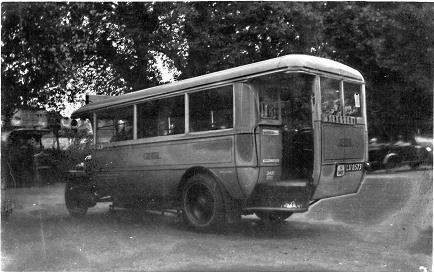 In June 1926, the General built 20 new
single-deck bodies and mounted them on former double-deck K-type
chassis. These 22 seat buses were allocated to Sutton for
operation of the new routes 155, 156,
157, 164 and
165 serving Morden Station when it opened that September, and
were painted silver to make them distinctive. Here, Sutton is
running K396 on the 113 instead. It is believed that the
whole batch were painted red on (or by) first overhaul in
1927. Photo © EGP Masterman
With the Kingston terminus having changed from Horse Fair to
the Bus Station in 1928, there were still some route changes to
come at the Carshalton end. First, in February 1935, the
direct Belmont to Sutton routing was replaced by an easterly route
using Banstead Road and Cambridge Road, but not yet serving
Carshalton Beeches and the Windsor Castle, which came in
May 1941.
In 1938, the route was altered at the eastern end by sending
every other journey down Sutton High Street to terminate at
Sutton Garage. At some later stage, possibly just after the
war, that part of the route was adjusted to approach the
garage via Vale Road rather than Bushey Road, allowing buses
to terminate outside the garage. This use ended on 28 April
1959.
During the war, the Scooters were modified to
perimeter seating, to increase the standing capacity. Whilst
the Scooters provided the main bus allocation through until the RF
era, other types were also officially allocated, including Ts then
Qs from K in 1936 and Ts in 1939. After the war, one T was
used Monday to Friday from the 215
allocation and Sutton provided Qs, then Ts, in 1948/49 to
supplement its Scooters. However, before the RFs the route
was well known for running almost any single-deck type - Ts of all
classes (and condition), CRs, Qs, TDs. Kingston's Scooters
were replaced by Ts in early 1950 and the allocation moved to
Norbiton on the opening of the new garage on 14 May 52.
The Scooters were past time-expired before the RFs
arrived. Sid Huxford was a conductor and then driver at
Sutton Garage and worked on the Scooters. He tells a story of
a colleague who was driving a Scooter on the 213, going flat
out down the steep hill of Staplehurst Road and reached the
bottom with a bump, whereupon some of the panels fell off.
Sid also remembers that the RFs were taller than the Scooters, so
the trees along the whole route needed to be cut back. This
was undertaken by a converted petrol-engined ST - probably 651J,
ex-Tilling ST870, which was based at Reigate.
Ian Danks lived in Carshalton Beeches from 1950 to 1963.
He recalls that on snowy or icy winter days the 213 was diverted
from the steep Staplehurst Road to use Banstead Road; John Parkin
adds that (at least later on) the diversion was from Cambridge Road
into Banstead Road (the route of today's S3).
CR16 is an example of the wide range of buses that worked the 213
in the years after the war and before the RFs arrived in
1952. Others are pictures here,
here and here.
Unfortunately, the little rear-engined Cubs had not had the
service life before the war for their revolutionary design to
settle down, and they remained unreliable. Here, CR16
working out of Sutton Garage has broken down by the
Kingston Bypass in New Malden. Fortunately this bus has
survived.
Photo ©
Alan Cross
That winter RFs were introduced, at A between 12 Dec 52 and 20
Jan 53 and NB 17 Dec 52 and 1 Jan 53. The route was
selected for an experiment with semaphore
trafficators, for which 24 RFs were so fitted. However,
it was soon found that these were dangerous to cyclists (or, in
Colin Curtis's words, it was found that cyclists broke them), so
the experiment was discontinued. To this day, RFs carry a
plated-over aperture for semaphores (as do many RTs). Alongside the RFs, a supplementary allocation of Ts
continued from NB at weekends until October, and on
Saturdays until 1955 when they were briefly replaced by
TDs. Unofficially, it seems that TDs also worked prior
to then. A reallocation between A and NB in November 1957 saw
one T again scheduled for six months. Kingston regained an
(RF) allocation on Sundays in August 1961, when Norbiton took on
part of route 14 on that day.
Shortly afterwards, in the changes of 3 Jan 62, the route was
diverted to serve Kingston Hospital and, except on Sundays,
curtailed at Sutton Garage, the Sutton to Belmont section being
covered by an extension of RT route 151. The diversion to Kingston
Hospital had the effect of avoiding the low bridge in Coombe Lane,
which is still there, and was perhaps prompted by the benefit of
having drivers used to the new routing before the route converted
to double-deck the following year. At about this time, the
road was lowered beneath the New Malden bridge, leaving Worcester
Park as the only obstacle to double-deckers. 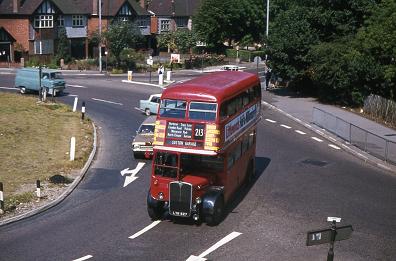
RT3308 crosses the Kingston
By-pass at New Malden in the last months of RTs on the 213.
For some of us, it comes as a surprise to find that RTs worked the
route for less than 10 years.
Over the winter of 1962/3, the road was lowered under the bridge at Worcester Park station enabling
another high traffic route to be double-decked with RTs. This
duly came about on 8 May 63, along with the introduction of the
213 A, which took a slightly different route between
Norbiton and Malden and took over the Sunday Belmont workings, and
the reintroduction of Kingston as one of the operating
garages.
In January 1966, Routemasters made their appearance on the
route on Sundays, working from NB, until the Sunday service was
withdrawn in 1969. Weekdays remained RT-operated until the
route converted to OMO with DMSs on 5 Aug 72.
The original 213 shrivelled and died in 1978, being replaced
by the 213A. In 1984, this was renumbered 213, and
apart from some early variations eastwards from Sutton Garage,
the route has run with double-deckers between Kingston and Sutton
ever since.
RF route in detail, with timing points
KINGSTON LT Bus Station, London Road, Coombe Road,
Norbiton Station, Coombe Lane,
Traps Lane, Coombe Road, New Malden
Station, New Malden High Street, Malden Fountain, Malden Road,
Worcester Park Station,
Central Road, Cheam Common Road, North Cheam Queen Victoria,
Malden Road, The Broadway, Cheam
Station Road, Cheam High Street, Cheam Road,
Sutton Carshalton Road High
Street, Carshalton Road, Park Hill, Carshalton Beeches Station, Beeches Ave,
Staplehurst Road, Banstead Road South, Downs Road, BELMONT
California (12 Dec 52 to 2 Jan 62)
KINGSTON to SUTTON GARAGE (usually alternate journeys): from
Sutton Carshalton Road High
Street via High Street, Vale Road (until 28 April 1959
only, then via Bushey Road, return via Bushey Road), SUTTON
GARAGE.
KINGSTON LT Bus Station, London Road, Norbiton Church, Kingston Hill, Galsworthy
Road, Coombe Lane, Traps Lane, Coombe Road, New Malden Station, New Malden High
Street, Malden
Fountain, Malden Road, Worcester Park Station, Central Road,
Cheam Common Road, North Cheam
Queen Victoria, Malden Road, The Broadway,
Cheam Station Road,
Cheam High Street, Cheam Road, Sutton
Carshalton Road High Street, High Street, Bushey
Road, SUTTON GARAGE (Mon-Sat). Extended Sundays from Sutton Carshalton Road High
Street via Carshalton Road, Park Hill, Carshalton Beeches Station, Beeches
Avenue, Staplehurst Road, Banstead Road South, Downs Road, BELMONT
California (3 Jan 62 to 7 May 63)
Based on 1955 bus map ©
London Transport
Frequency
| Year |
Mon-Fri |
Sat |
Sun |
| 1936 |
10-15 mins |
10 mins |
10-15 mins |
| 1941* |
6 mins |
6 mins |
7½ mins |
| 1946† |
3-6 mins |
3-6 mins
|
3-6 mins |
| 1951* |
4-6 mins |
4-6 mins |
4-6 mins |
| 1959* |
5-10 mins |
4-6 mins |
5-8 mins |
* of which alternate journeys terminated at Sutton Garage and
Belmont.
† of which Belmont journeys were every 8-12 mins.
From Kingston, the route took about 45 minutes to reach
Sutton Garage and 55 minutes to reach Belmont. The 1959
timetable is here.
Faretable
To view the faretable for 1965, by which time the route was
RT-operated, click here. This includes route
213 A, note that the Kingston to Sutton
Garage journeys on the 213 are covered by
213 A.
RF allocation
New RFs delivered Dec 52-Jan 53: Sutton: 372, 374, 381, 386,
388, 393-407, 415, + 298, 340 second hand (22 + 1 spare),
Norbiton: 375, 379, 383, 389-392 + 293, 296 second hand) (9,
no spares), plus 499 to Sutton 3/53
PVR 1952 (Dec): Mon-Fri 30 (21 A, 9 NB), Sat 31 +
5T (22 A, 9 + 5T NB), Sun 28 + 1T (19 A, 9 + 1T
NB)
PVR 1953 (May): Mon-Fri 29 (20 A, 9 NB), Sat 30 +
5T (21 A, 9 + 5T NB), Sun 27 + 1T (18 A, 9 + 1T
NB)
PVR 1953 (Oct): Mon-Fri 29 (20 A, 9 NB), Sat 31 +
4T (21 A, 10 + 4T NB), Sun 29 (19 A, 10
NB)
PVR 1954 (May): Mon-Fri 29 (20 A, 9 NB), Sat 32 +
3T (21 A, 11 + 3T NB), Sun 29 (18 A, 11
NB)
PVR 1954 (Oct): Mon-Fri 29 (20 A, 9 NB), Sat 32 +
3T (21 A, 11 + 3T NB), Sun 28 (17 A, 11
NB)
PVR 1955 (Mar): Mon-Fri 29 (20 A, 9 NB), Sat 32 +
3TD (21 A, 11 + 3TD NB), Sun 28 (17 A, 11
NB)
PVR 1955 (May): Mon-Fri 29 (20 A, 9 NB), Sat 35 (21
A, 14 NB), Sun 28 (17 A, 11 NB)
PVR 1955 (Oct): Mon-Fri 29 (20 A, 9 NB), Sat 35 (21
A, 14 NB), Sun 29 (23 A, 6 NB)
PVR 1956 (May): Mon-Fri 29 (20 A, 9 NB), Sat 35 (21
A, 14 NB), Sun 28 (21 A, 7 NB)
PVR 1958 (Apr): Mon-Fri 26 (18 A, 8 NB),
Sat 32 (23 A, 9 NB), Sun 22 (18 A, 4
NB)
PVR 1958 (Nov): Mon-Fri 22 (15 A, 7 NB),
Sat 28 (20 A, 8 NB), Sun 21 + 1T (13
A, 8 + 1T NB)
PVR 1959 (Mar): Mon-Fri 24 (16 A, 8 NB),
Sat 28 (20 A, 8 NB), Sun 21 + 1T (13
A, 8 + 1T NB)
PVR 1959 (May): Mon-Fri 24 (16 A, 8 NB),
Sat 28 (20 A, 8 NB), Sun 22 (13
A, 9 NB)
PVR 1961 (May): Mon-Fri 24 (16 A, 8 NB),
Sat 28 (20 A, 8 NB), Sun 19 (11 A, 8
NB)
PVR 1961 (May): Mon-Fri 24 (16 A, 8 NB),
Sat 28 (20 A, 8 NB), Sun 19 (11 A, 8
K)
PVR 1962 (Jan): Mon-Fri 23 (15 A, 8 NB),
Sat 26 (18 A, 8 NB), Sun 20 (12 A, 8
K)
PVR 1962 (Oct): Mon-Fri 23 (15 A, 8 NB),
Sat 26 (18 A, 8 NB), Sun 16 (10 A, 6
K)
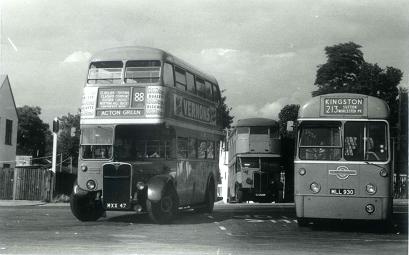
Belmont stand on 2 Aug 53.
Merton's RT2958 and Norbiton's RF293 await departure on the 88 and
213 respectively. RF293 was one of the two 'second-hand'
RFs delivered to Norbiton for the conversion of the
213. The fifth red RF, it was one of the batch delivered
to Muswell Hill for the 210, soon
replaced by a further batch and sent out as trainers prior to
the introduction of the remainder of the fleet. RF293
went to help prepare Sidcup; later, it was one of the batch
converted to Green Line (but not renumbered).
David Roland-Shrubb
(below) refers to the staff canteen
at Belmont. Here 693J, the former Tilling ST922, sits in
the background. Both the RT and the RF are less than a
year old, illustrating the renewal of the bus fleet after the war
that enabled the withdrawal of buses such as the ST, which
dates from 1930. ST922 is now restored and resides at
the London Bus
Museum ('Cobham').
Photo © Alan
Cross
Memories
Derek
Fisk provided an excellent history of
buses in North Cheam, including most importantly the 213, for
our Worcester Park running day.
David Roland-Shrubb
commented on a previous version of this page - when it
had said “in 1938, some journeys were terminated at Sutton
Garage” - 'it almost reads as if this happened on a whim - the
conductor needed the loo, the driver fancied a cigarette, or
neither fancied the tea on offer in the ex-Tilling ST staff
canteen at Belmont. In fact every
alternate bus terminated inside Sutton Garage, normally entering
through the refuelling/washdown bay and parking adjacent to the
offices just inside the garage exit facing the direction of the
High Street to which they returned via Bushey Road.
Originally they travelled to the garage this way also, but
sometime in, I think, the late 1940s all buses returning to the
garage were diverted along Vale Road - possibly to avoid the 654
trolleybus turning circle at the junction of High St and Bushey Rd.
However, I seem to recollect that for some reason the 156 was
excluded from this diversion.
As a boy I lived in Cheam (1939 – 1955) and the 213 and 156
passed our house on Malden Road. I knew that if a Belmont bus came
along the next one would be going to the garage and (more
important) would be passing the Marks & Spencer’s bus stop on
the High Street where us Grammar School boys would alight. In
those days the headway between Kingston & Sutton was 4 – 6
minutes and 8 – 12 minutes between Sutton & Belmont.
I remember once coming out of the Granada cinema in North Cheam
(where Sainsbury's is now) to discover a blanket of fog so dense
that when a 156 did appear the conductor was walking in front of it
holding a flare! I also remember the top shed of Sutton
garage (it might well have been 1947) full of Daimlers all with
their engines running at around midnight to prevent the radiators
from freezing. The night staff apparently had to start them all up
every two hours but I don't know for how long they ran them. The
atmosphere thus created is better imagined than experienced!'
Re-creation
The 213 was operated by RFs at our Worcester Park running day in 2008. RFs
will operate again on 2 Dec 2012 to mark the 60th anniversary.
|
|